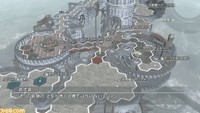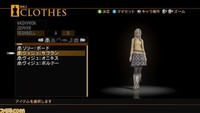|
|

|
PLATFORM
|
PS3
|
BATTLE SYSTEM
|

|
INTERACTION
|

|
ORIGINALITY
|

|
STORY
|

|
MUSIC & SOUND
|

|
VISUALS
|

|
CHALLENGE
|
Hard
|
COMPLETION TIME
|
40-60 Hours
|
|
OVERALL

|
+ Battle is the perfect mixture of skill and luck.
+ Very little grinding needed if played right.
+ You get to play dress-up!
+ Storyline is dark and mysterious...
- ...but can be hard to understand.
- Battle and NPC voices get very repetitive.
|
Click here for scoring definitions
|
|
|
Let me say this up front — I like tri-Ace. I usually pick up any game developed by them, even if it appears to be below average. Needless to say, I was excited when, shortly after its Japanese release as End of Eternity, Resonance of Fate was announced for the US on the PlayStation 3 and Xbox 360. For reasons unknown, Resonance of Fate was released exactly one week after the highly anticipated Final Fantasy XIII. I will have to admit, after playing both, that I enjoyed Resonance of Fate much more than Final Fantasy despite its inferior graphics, music, character selection, and environments. What you'll find in Resonance of Fate is a game that is quite different than most others, and one that requires a fair bit of thinking both in and out of the battlefield.
One of the stand out features of Resonance of Fate is its story. The basic premise is that a catastrophe occurred and now mankind lives in a gigantic, mechanical tower called Basel with all life being controlled by Basel in some mysterious way. Spanning up above the clouds, Basel is a vast network of mechanical clockwork of unknown origin, giving a very steam-punk feel to the environment. The world map is covered by hexes which must be unlocked in order for the party to travel, something that is justified narratively by Basel being in a state of degradation. The game starts off with the female lead, Leanne, attempting to commit suicide and being saved by Zephyr, the younger male lead, who is part of a mercenary group lead by Vashyron, the third and final playable character. The rest of the story, for the most part, is obscure to say the least. Various hints are dropped about unwholesome activities by the Cardinals, the ruling class, mysterious quartz gems, a horrific massacre, and more than a few dark scientific experiments. The game very seldom, however, comes right out and explains anything that happens. Figuring out the plot is mostly left up to the player and while the sudden revelation of understanding will bring enjoyment to many RPGamers, more than a few may be put off by the obtuse storytelling. Players will know little more than the protagonists, which is a welcome change from other games in which the player is infinitely more informed than the characters.
Combat is a key aspect to Resonance of Fate with the majority of battles revolving around efficient use of the Hero Gauge. This gauge, which grows over the course of the game by completing certain tasks, is tied not only to special actions in battle, but also to your party's continued survival. Damage comes in two forms: scratch and direct. Scratch damage, a pseudo-temporary damage, is dealt by machine guns and various status effects. Direct damage, inflicted by handguns, grenades, and a few ailments, converts scratch damage into real HP damage. The Hero Gauge can save your party's life by exchanging a charge for 1000 scratch damage, but only up to a certain point. Once the gauge is empty, all damage taken by the party is converted to direct damage. Luckily, Hero Points are regained by destroying enemies, which adds another dimension of strategy to battles and directly influences your continued success.
 Hell hath no fury...
Hell hath no fury...
|
|
While the Hero Gauge can be seen as a lifeline of sorts, its main application is for the execution of Hero Actions. Though you can just stand still and shoot at your opponents, this leaves characters open to enemy fire and dramatically reduces the damage potential for that round. Instead, most battles will utilize Hero Points to have a character launch through the air, unloading hundreds of bullets at enemies while remaining invincible. In addition to Hero Actions, Tri-Attacks can also be used to have all three characters participate at the cost of a Hero Point and at least one Resonance Point. Resonance Points are obtained by performing a Hero Action between the two other characters; the more Resonance Points you have, the longer the Tri-Attack is sustained. Overall, battles require a fair amount of thinking, but you're given plenty of time to do so; enemies will neither move nor attack as long as you stay still. Unfortunately, the battle system can be a little daunting when first starting the game. It can take anywhere from a few battles to a few hours to fully get the hang of the system, especially in terms of efficiently utilizing the special ammo and grenades available and maintaining the Hero Gauge. Once the system is understood, however, battles become much more enjoyable.
Character level advancement is the summation of three separate weapon levels: machine guns, handguns, and grenades. Gaining weapon levels not only increases the maximum charge capacity for the weapon category and its associated skills, it also increases the character's stats in two ways. Each weapon level gained increases the character's maximum HP as well as his maximum equipment burden and adds various skills to weapon attacks. The vast majority of the weight parameter goes toward being able to equip a second gun or to equip guns with increasingly more upgraded parts. Gun customization is the main area of focus for increasing character power, and a good deal of time gathering and attaching components is required to make the most efficient use of each weapon. While gun customization is fun, it eventually becomes more than a little ridiculous once a simple handgun mutates into a monstrosity with eight barrels and six scopes — especially when one of those barrels was pointing down at what would be the characters' feet, if not worse. The greatest benefit of the customization system and the way that leveling works is that grinding is unnecessary as most leveling can easily be done over the course of the main story and various side missions. Players finding that they don't have enough HP or weight capacity will usually only have to spend a few battles with an underleveled weapon in order bring it up to speed. The only time that any real grinding may be required would be when looking for certain hexes or materials, but this shouldn't be a normal occurrence.
 Paving the way to success, one hex at a time.
Paving the way to success, one hex at a time.
|
|
The greatest difficulty comes with learning how best to use the battle system. While this becomes much easier over time, even experienced players will find that there are certain places in the game, especially toward the end, in which the difficulty spikes. While strategic use of status effect inducing and defense exploiting grenades as well as ammunition help to an extent in these battles, difficult ones are sometimes completely dependent on luck. The difficulty does, however, add to the enjoyment of the game. While you could grind for hours to max out weapon skill levels, taking the time to think and prioritize attacks will accomplish the same goal. Completing the main story and all sidequests takes between forty and sixty hours, though it could take quite a bit more if the (repetitive and grindy) arena, bonus dungeon, or all of the game's trophies are tackled. This can be extended much more with the new game plus and higher difficulty settings. While a new game plus will let you start over in the same difficulty with most of your items and levels, starting a different difficulty will reset your party back to the beginning. Including the default mode, there are a total of eleven difficulties, all unlocked sequentially and having increased enemy stats and damage. The only detriment to this system is that playing on the hardest mode requires a total of ten previous completions, a daunting task to say the least.
While the music and visuals of Resonance of Fate aren't bad by any means, they fall short of being great. The environments are interesting and show considerable detail, often showing the moving gears of Basel. While the different locations fit in perfectly with the steam-punk feel, most areas, and dungeons in particular, feel very repetitive and show little variation. The same can be said about most enemy models; many opponents are simply variations of earlier ones. Though you could easily describe the environments as being dull or drab, they feel more bleak than anything else, adding to the feel that Basel is a society in decay, rife with problems. There is one visual aspect that definitely shines in Resonance of Fate; while completely optional, the appearances of the three main characters are highly customizable. Players are given the option to change everything from hair and eye color to clothing and accessories. The designs available range from simple solid colors to vivid designs and also include various promotional pieces such as SEGA and Resonance of Fate shirts. Playing dress-up may not be fun for everyone, but it definitely adds some much needed visual variation to the game. The musical score, while nice, falls short due to excessive repetition. Towns and certain events have unique music, but dungeons mostly share the same, repeated tracks. Neither of these aspects detract from the overall experience, but they don't add much either. Even a few additional dungeon tracks and environments would have gone a long in these areas.
 They're not dolls, they're action figures!
They're not dolls, they're action figures!
|
|
In terms of localization, players will find that both the dialogue and voice acting are, for the most part, done well. As a consequence of budget and time constraints, however, only main story cutscenes, certain flavor and story related battle voices, and a small pool of generic NPC lines were voiced for the English version. Where the original version was fully voiced, initiating a conversation with an NPC will cause a generic, oft-recycled line to be played that may or may not have any relation to what they are actually saying. Frankly, these NPC dialogue snippets may just as well have been left out entirely. Fortunately, the option exists to play the game with the complete Japanese vocals.
Resonance of Fate probably isn't for everyone. The battle system requires much more than simple button mashing and the story necessitates a certain level of critical thinking in order to understand its more subtle points. RPGamers who are able to become proficient with the battle system and deal with the enigmatic plot will find, however, an enjoyable game with interesting characters, a well implemented battle system, loads of character customization, a plethora of content for hardcore completionists, and a smattering of humorous dialogue. Resonance of Fate probably won't be named game of the year or end up on a Greatest Hits list, but it is definitely one of the more enjoyable RPGs that I've played recently and should be taken into consideration the next time you need an RPG fix.
Review Archives
|









